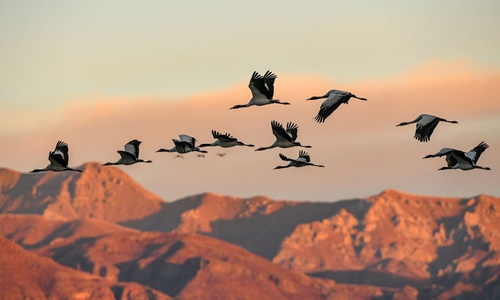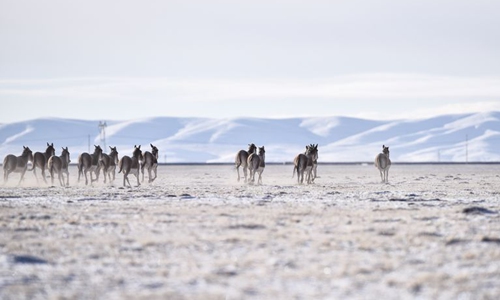HOME >> CHINA
China steps up wildlife conservation amid coronavirus outbreak
Source:Xinhua Published: 2020/2/5 15:40:44

Black-necked cranes fly over a natural reserve for the birds in Lhunzhub County, southwest China's Tibet Autonomous Region, Jan. 1, 2019. (Xinhua/Zhang Rufeng)
Wearing a mask, Gerusherab braved the bitter cold to start his daily patrol on a motorbike in the Sanjiangyuan National Park, a haven for wildlife, which is located in northwest China's Qinghai Province.
Over the Spring Festival holiday, the 27-year-old man and other park rangers have intensified their patrols, as more cases of the novel coronavirus infections were reported.
Previous investigations indicated that wild animals could have played a key role in the emergence of the disease. But it remains unclear what kind of animal caused the infection.
Located on the Qinghai-Tibet Plateau, Sanjiangyuan, known as the headwaters of the Yangtze, Yellow and Lancang rivers, is home to hundreds of species of wild animals, many of which are under state protection, such as wild yaks, snow leopards, Tibetan antelopes and Tibetan gazelles.
"We inspect whether there are dead wild animals along the roads every day," Gerusherab said.
Park rangers need to report every wild animal found dead of unknown causes to the local disease control and prevention departments, and the carcasses will be disposed of to prevent the spread of diseases.
Forest police have also strengthened measures in the park to crack down on illegal acts of trafficking, poaching and hunting wild animals.
In the eyes of Kangje, also a park ranger, the coronavirus outbreak has cautioned the government and the public about the importance of wildlife conservation.
Apart from Qinghai, other parts of the country have also taken prompt measures to protect wild animals and fight against wildlife trading.
The Administration for Market Regulation of south China's Guangdong Province said Tuesday that it has joined hands with 12 provincial departments, including the department of ecology and environment and the public security department, to launch an action against illegal wildlife trade across the province.
The action orders a ban on all forms of wildlife trade in marketplaces and restaurants.

Kiangs are seen in Hoh Xil, northwest China's Qinghai Province, Dec. 2, 2016. The quantity of wild animals in Sanjiangyuan increased year by year due to the enhancement of local wild animal protection awareness. (Xinhua/Wu Gang)
The forestry bureau of southwest China's Chongqing Municipality has also banned wild animal trading and strengthened measures of wild animal management and control.
The local government has called a halt to all kinds of related activities such as wildlife transport, exhibitions and performances.
Chongqing has also tightened the monitoring of epidemic diseases of terrestrial wildlife and carried out a daily report system. Forest rangers have been urged to intensify patrols in the wild. The government requests prompt reporting of any abnormal deaths of wildlife and thorough investigations.
Forest police in south China's island province of Hainan said they have detained a suspect in late January, who confessed to hunting wild animals in a nature reserve.
In an effort to curb the spread of the epidemic, the public security department of Hainan has teamed up with the local forestry department and market regulation department to thoroughly check farm products markets, pet markets and restaurants, and intensify efforts to crack down on illegal acts of hunting, purchasing, transporting, selling and processing wild animals.
In east China's Jiangxi Province, around 6,000 police officers have been dispatched to get tough on wildlife crimes over the past two weeks.
Posted in: SOCIETY